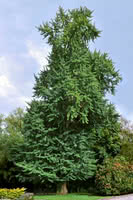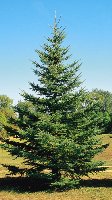Mon-Fri 9am - 5pm Mountain time
Ginkgo Biloba vs Black Hills Spruce
Ginkgo biloba
Picea glauca var. densata
NOT AVAILABLE THIS SEASON - MIGHT RETURN
The Ginkgo Biloba is regarded as one of the most distinctive and beautiful of all the deciduous trees, and has remained genetically unchanged for millions of years. Its beautifully fan-shaped leaves develop a clear yellow colour in fall. Graceful and attractive year-round, Ginkgo is the perfect conversation starter in your yard.
Black Hills Spruce is a subspecies of White Spruce native to the Black Hills of South Dakota. It has a strongly conical form, slower growth rate and denser foliage than typical white spruce, making it preferable as a specimen tree for smaller suburban lawns. It also responds well to pruning, and can be used as a hedge or even bonsai.
Ginkgo Biloba Quick Facts
Black Hills Spruce Quick Facts
Toxicity: Uncooked nuts in large quantities
In row spacing: 3 - 4 m (10 - 12 ft)

